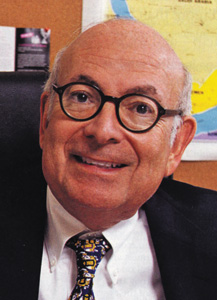Anti-Semitism exhibit is chilling reminder of enduring hatred
Published December 26, 2012
The St. Louis Jewish Community Archives, which operates within — and in cooperation with — the Saul Brodsky Jewish Community Library, is a treasure-trove of documents, artifacts and other information of Jewish life in St. Louis, dating back to 1807. Diane Everman, director of the Archives, is a major source of information for these Cohnipedia columns, and played a major role in compiling information for the powerful exhibit “Standing for Justice: Anti-Semitism and Discrimination in St. Louis, 1930-1950.”
The exhibit at the St. Louis Holocaust Museum through the month of January, is a collaborative project involving the HMLC, the Brodsky Library and the Jewish Community Archives and the Jewish Community Relations Council.
Along the walls of the theater and screening room at the Holocaust Museum are enlarged story boards of photographs, lurid anti-Semitic cartoons, reproductions of flyers and notices to boycott Jewish-owned stores, posters warning against war to “save the Jews,” and material that was openly supportive of the rise of Adolf Hitler and the Nazis in Germany, among others.
In an especially disturbing photograph, a large group of members of the St. Louis Chapter of the German American Bund, marching in a public park, wear Nazi-like uniforms and carry swastika flags alongside American flags. Many members of the local German American Bund were enthusiastic supporters of Hitler’s rise to power in Germany and wanted to publicly show their support at every opportunity. Their exploits are described by local mystery novelist Michael Kahn in his book “Bearning Witness: A Rachel Gold Novel,” which is available at the Brodsky Library.
Numerous cartoons depicting Jews as hooked-nose evil capitalists with dollar signs adorning their clothing appear as do ones of Jews as Communists, determined to undermine and eventually overthrow the government of the United States.
During the 1930s, even before Hitler came to power in Europe, anti-Semitism was on full display in St. Louis. Col. Charles A. Lindbergh, the “Lucky Lindy” who became a world hero when he completed his solo flight across the Atlantic from New York to Paris, became an early advocate of an “America First” policy, warning of the “folly” of going to war to save the Jews. Later, Lindbergh would visit Nazi Germany, where he happily accepted a medal presented to him by Hermann Goering, head of the German Air Force. The medal is in the collection of Lindbergh artifacts at the Missouri History Museum’s research branch in the former United Hebrew building on Skinker Boulevard.
Two of the major figures of rabid anti-Semitism also had supporters in St. Louis: Father Charles E. Coughlin, described by Anti-Defamation League officials as a “Jew-baiting radio priest,” who during the 1930s had over three million listeners, and Rev. Gerald L. K. Smith, who for many years ran a Christian tourism center in Eureka Springs, Ark. that featured a virulently anti-Jewish “Passion Play.” The ADL, which nationally and locally has taken the lead in combatting overt anti-Semitism and bigotry, described Smith as having been “teacher, mentor or associate of most of the important anti-Jewish propagandists” for over four decades, and was the leader of the Christian Nationalist Crusade, which published anti-Jewish, anti-Catholic and anti-African-American propaganda for many years.
At the exhibit one of the panels describes the role of Smith and Coughlin in St. Louis. “St. Louis in the 1930s and 1940s was a major railroad hub and geographically central, making it a Mecca for religious and political extremists. Extremists such as Father Charles E. Coughlin, Gerald L. K. Smith and the American Tract Society were headquartered or maintained offices in St. Louis, and targeted all of Missouri. Although Smith eventually moved his office, several members of his inner circle maintained St. Louis as their base. Father Coughlin, the notorious ‘radio priest,’ while not a local resident, was a frequent visitor and speaker.” The exhibit features a blow-up of a letter sent by Coughlin to a St. Louisan in which Coughlin denies his well-documented bigotry.
How did the St. Louis Jewish and general communities respond to the challenges posed by the anti-Semitic and pro-Nazi extremists in their midst? According to the exhibit, “While these extremists did not use violence, they were expert agitators and propagandists who employed any means at their disposal. Through mass meetings, publications, radio programs and other types of media, they spewed their messages of hate, bigotry and intolerance.”
When in 1953, Julius and Ethel Rosenberg were accused, tried and executed on charges that they attempted to share atomic weaponry secrets with the Soviet Union, a new wave of anti-Semitism flared against “Jew Communists.” Even though the actions of the Rosenbergs were condemned by all Jewish organizations, Jews were still targeted collectively for the acts of a few.
The more things change, the more they stay the same. One can visit numerous neo-Nazi websites today and find the same kinds of lurid and vile anti-Semitic propaganda, tracts and cartoons that were widely circulated in our community in the period covered by the exhibit. Fortunately, we today have such resources at the JCRC, the ADL, the Holocaust Museum, the Brodsky Library and the St. Louis Jewish Community Archives to better prepare us to deal with such bigotry than we had back in the early 1930s.
















